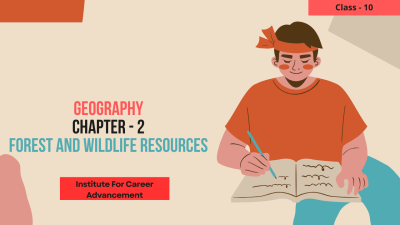Forest and Wildlife Resources - Class 10
Forest and Wildlife Resources is a crucial chapter in Class 10 Geography that explores the significance of forests and wildlife in our ecosystem. It delves into the types of forests, their distribution, and the importance of conserving both forests and wildlife. Key topics covered in this chapter include: Types of Forests: Tropical, temperate, and coniferous forests. Distribution of Forests: Global patterns and factors affecting forest distribution. Importance of Forests: Ecological, economic, and social benefits. Forest Depletion: Causes, consequences, and efforts to conserve forests. Wildlife Resources: Types, distribution, and importance. Wildlife Conservation: Challenges and strategies for protecting wildlife. National Parks and Wildlife Sanctuaries: Their role in conserving biodiversity. By studying this chapter, students gain a deeper understanding of the interconnectedness of forests and wildlife, the threats they face, and the importance of preserving these valuable resources for future generations. বন ও বন্যপ্রাণী সম্পদ দশম শ্রেণির ভূগোলের একটি গুরুত্বপূর্ণ অধ্যায় যা আমাদের বাস্তুতন্ত্রে বন ও বন্যপ্রাণীর গুরুত্ব অন্বেষণ করে। এটি বনের ধরন, তাদের বন্টন এবং বন ও বন্যপ্রাণী উভয়ের সংরক্ষণের গুরুত্ব নিয়ে আলোচনা করে। এই অধ্যায়ে অন্তর্ভুক্ত মূল বিষয়গুলি হলঃ বনের প্রকারঃ ক্রান্তীয়, নাতিশীতোষ্ণ এবং শঙ্কুযুক্ত বন। বন বিতরণঃ বন বিতরণকে প্রভাবিত করে এমন বৈশ্বিক নিদর্শন এবং কারণ। বনভূমির গুরুত্বঃ পরিবেশগত, অর্থনৈতিক ও সামাজিক সুবিধা। বন হ্রাসঃ বন সংরক্ষণের কারণ, পরিণতি এবং প্রচেষ্টা। বন্যপ্রাণী সম্পদঃ প্রকার, বিতরণ এবং গুরুত্ব। বন্যপ্রাণী সংরক্ষণঃ বন্যপ্রাণী রক্ষার জন্য চ্যালেঞ্জ ও কৌশল। জাতীয় উদ্যান ও বন্যপ্রাণী অভয়ারণ্যঃ জীববৈচিত্র্য সংরক্ষণে তাদের ভূমিকা। এই অধ্যায়টি অধ্যয়নের মাধ্যমে শিক্ষার্থীরা বন ও বন্যপ্রাণীর আন্তঃসংযোগ, তারা যে হুমকির সম্মুখীন হয় এবং ভবিষ্যৎ প্রজন্মের জন্য এই মূল্যবান সম্পদ সংরক্ষণের গুরুত্ব সম্পর্কে গভীর ধারণা অর্জন করে।
English
Last updated
Wed, 27-Nov-2024



















